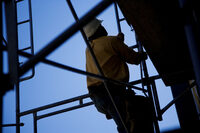 Construction sites are one of the most dangerous places of employment. Workers are exposed to any number of hazards on a daily basis. However, the majority of all accidents and deaths in the industry can be avoided by simply following basic safety rules.
Construction sites are one of the most dangerous places of employment. Workers are exposed to any number of hazards on a daily basis. However, the majority of all accidents and deaths in the industry can be avoided by simply following basic safety rules.
Falls
While falls from unguarded heights are a major concern, heights are not the only fall issue that must be addressed. Improper ladder use is a source of many site injuries. Workers can be injured by tripping over debris or extension cords carelessly placed in walkways. Additional risks come from open trenches or excavations.
Follow the standard OSHA guidelines to reduce fall dangers:
- When workers are more than six feet above ground, or a lower floor level, they must have some form of fall protection. This rule also applies to residential roof work.
- Ladders must be angled correctly with the proper footing.
- Weight limits for ladders must be followed.
- Ladders must be inspected on a routine basis and broken ladders must be taken out of service.
- Keep the work areas clean. Debris, materials and tools left in walk areas present trip hazards.
- Open trenches must be roped or barricaded.
Electrocution
Electricity is not just a danger to electricians on a job site. All workers must be trained to work safely around electrical wires and equipment. One area that presents a danger is improper use of electrical cords. Cords should never be run across pedestrian or equipment paths.
Extension cords are easily damaged. Once a cord is broken or frayed, it must be taken out of service. A break in the insulation can cause a serious electrical shock. The ground prong on cords should never be removed for use in a two-prong outlet. Ground Fault Circuit Interrupter (GFCI) protection must be used for wet location work.
Lockout devices are required when any employee is servicing equipment or working on a circuit that would otherwise be live. All site employees must be trained in the use of lockout systems. Only the worker setting the lock or a responsible party should ever remove the tag.
Head injuries
Falling objects are one source for significant and often deadly head injuries. All workers on construction sites should use approved hard hats. Safety netting and kick plates used on upper levels help prevent dangerous objects from falling and causing injury.
What is often forgotten is that falling objects are only one head injury danger. An employee carrying long pipe materials or two-by-fours can easily turn without realizing that another individual is within impact radius. While the amount of impact may not be deadly, any head injury can be serious.
Heavy equipment
Training and certification for equipment operators is the first step in keeping heavy machinery from becoming a hazard on construction sites. Unfortunately, operators are not the only cause for accidents. Observers and workers in the area often place themselves in bad situations that can easily be avoided.
Construction sites attract onlookers. When used appropriately, barricades will keep most observers out of harm’s way. If you are running a very large operation, security personnel should be employed.
Construction crews must be trained in the dangers of working around heavy equipment. Accidents occur frequently when an employee is behind equipment that is backing up. Caught-between accidents are often deadly. Workers on sites that require them to be around moving equipment should be supplied with high-visibility vests.
Spotters for heavy equipment operators can greatly reduce hazards. This work requires special training in hand signals. Only one spotter should guide one equipment operator. Multiple workers will create confusion.
HVAC
Much of the work during any construction project is done inside. During the majority of this stage of a project there are little to no Heating, Ventilation and Air Conditioning (HVAC) systems in operation. Workers still require basic heating and cooling to avoid cold hazards and heat exhaustion. Ventilation during many operations can be critical.
Portable heating systems and generators must be used with caution. Gas powered equipment creates carbon monoxide. The fumes must be ventilated to protect workers from health hazards. Portable electrical heating and cooling systems will not produce toxic gas.
When looking at HVAC options, consider the fact that a small investment does more than just provide safety benefits. When workers are too cold or overheated, they do not perform as well. Portions of some projects can require more time and materials for completion. Trying to pull communications wires in freezing temperatures is futile; the wires become brittle and will snap in extreme cold.
Look around your construction site and observe the many areas that present safety hazards. A few simple steps can save you and your crew from costly injuries.
Author bio:
Dale Allen is the National Service Manager of Rankin, one of the nation’s leading temporary heating and cooling companies.